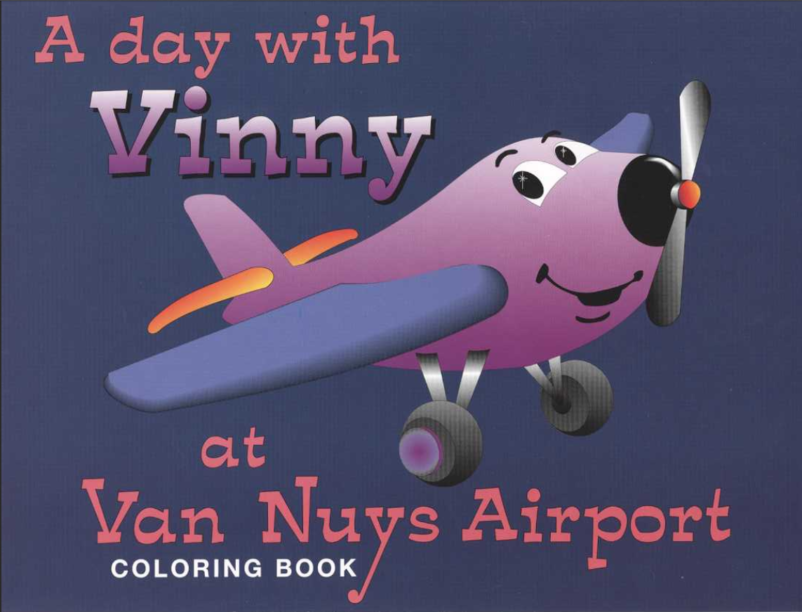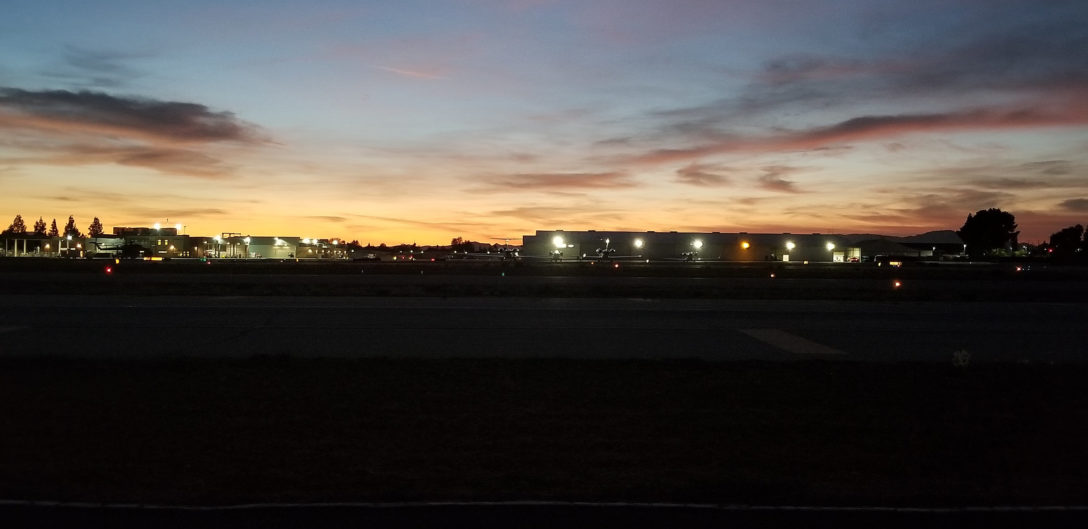The first Los Angeles airport I ever flew into was Bob Hope, in the early 2000’s. Back then, I was dazzled by the SoCal atmosphere: the convenient chill of gorgeously tanned people in fashion sweatpants, sunny music piped inside and out, which I remember as the Beach Boys but it couldn’t have really been the Beach Boys.
The one I’ve travelled through the most is LAX, which at first impressed me with its sleek and efficient circular structure so unlike the haphazardly scattered big-box hangars of my hometown JFK, and slowly came to torment me with its panic-inducing holiday traffic and accursed late-night freeway on-ramp closures.
But the first and only airport in LA that I can really think of as my own is VNY, in good old Van Nuys.
I don’t go to the Van Nuys Airport to get on a plane. Rather, every once in a while, when all the other activities in the regular toddler entertainment rotation have gone stale I take my daughter and meet up with some members of our gang in its Observation Area and the kiddos don helmets and mount scooters and propel themselves back and forth along the mini-runway, decorated with cartoonish clapboard cutouts of planes and control towers. The one amicable but ailing grandpa-in-tow dons his safari hat and sits on a bench, his back to us, peacefully watching the arriving and departing planes with a set of binoculars like he’s got an eternity to do so.
We stand and perspire and talk: one of us actually made it out to a live music show over the weekend, another pulled her old script out of a drawer, and then someone falls off his or her scooter and gets a scrape and it’s kisses and snack and water bottles with the built-in straws and then airplane arms back to car seat straps and home for nap time and if it’s not a pre-school or babysitter day, a stolen hour or two of furious work.
The observation area is sort of a guilty secret. Maybe because its located in a mildly sketchy area, immediately flanked by large bus parking lots and truck depots and smoke shops to the North, a gigantic yeasty Budweiser plant and the 405 to the East, office and trailer parks to the West, and the not-quite-gentrifying Lake Balboa to the South (hint: it’s still really just Van Nuys). Or maybe because it is not at all upgraded or aspirational, and the toddlers eat their organic cheese sticks and grain free paleo puffs while breathing in hearty lungfulls of jet and diesel fumes, probably taking in more carcinogens in one morning than all the secondhand smoke my generation was exposed to throughout our entire childhoods. But once you get past superficial parent pleasantries at music class or tot gymnastics you realize everyone goes there, and everyone loves it.
 Photo: IFLYVNY.com
Photo: IFLYVNY.comWith the attitude VNY evokes, a combination of performed (but felt) ambivalence and secret (but true) relief, perhaps it is emblematic of Valley living. Like Sandra Tsing Loh before us, we all still move to the Valley because it’s affordable, and then we ride the predictable waves: thankful for a mortgage that won’t give us regular heart attacks, bummed out by the never-ending fast food joints. Thankful for the peaceful stable life we’ve finally got a toe-hold on (just in the nick of time!), a bit crestfallen that this stability means we now have to drive at least forty minutes to get to our favorite Atwater bakery or K-town mall. Happy gazing out at the Santa Susana mountains purple in the dusk when there is the occasional view to be stolen, cranky that there is nary an even subtly sloping hilltop to be had until you reach those mountains—the visual interest of Echo Park and Silverlake topography just a bittersweet memory. Happy about convenient parking, dismayed that convenient parking is something that even crosses our mind, because we are now officially middle-aged.
Much like we all feel like we used to live more exotic lives in previous decades, the airport has a glorious past belied by its humble shades of grey and its mascot Vinny, an overweight but optimistic two-seater airplane. Opened in 1928, it was the base for record breaking flights by crush-inducing female pilots like Elinor Smith (the “Flying Flapper of Freeport”) and Bobbi Trout, who together in 1929 flew the longest endurance flight (42 hours). Florence “Pancho” Barnes, who founded the first movie stunt pilot union, took off from Van Nuys in 1930 and broke Amelia Earhart’s speed record (196 mph). Bootleggers flew booze here from Mexico. The final scenes in Casablanca were shot here and Marilyn Monroe—then, of course, Norma Jean—was discovered on its aircraft assembly line during WWII. In 1996, VNY’s annual Aviation Expo granted LA its first public sightings of the B-2 Stealth Bomber (an aircraft that even I, decidedly not a vehicle person, have heard of) and in 1998 showcased the intriguing “elite” U.S. Army Golden Knights Parachute Team (I picture men in blazing part-medieval-part-luchador unitards and face armor, descending from the clouds in synchronized formation like buff angels).
No major airlines fly here and yet it somehow gets shit done; since the early seventies it has been one of the busiest general aviation airports in the nation. But you wouldn’t know that to look at it. Air traffic is slow enough that you notice each small plane coming in or taking off; a Beechcraft, a Cessna, the grandpa announces, the same way he’ll identify a mallard or a coot when we go to another Valley favorite, Lake Balboa Park, with its perpetually off-smelling pond.
In this, too, perhaps VNY is also emblematic of the mid-valley, where past glories have technically left a trace but have long since lost even a whiff of their former glamour, while its people continue to do the jobs that keep the city running. In my neighborhood of Reseda, just ten minutes away from VNY, the South Seas building on Saticoy was the cinematic home of The Karate Kid, providing the California apartment where he and his mom landed to make their fresh start. Not far away in Northridge, Cher used to rent out the Skateland roller rink for epic parties that lasted entire summers. The now-defunct Reseda Country Club on Sherman Way once featured James Brown, Captain Beefheart, Mick Jagger, and Prince. Today you’d drive right by any one of these pop culture landmarks, which blend in perfectly with the rest of the totally unremarkable and decades-outdated built environment.
From even a very small distance it’s easy to miss the Valley charm. Yet we’ve been welcomed by our neighbors, each a world unto themselves. Red-haired Dottie on the corner who lives in the house she grew up in leaves lipstick kisses on our rescue pit-bull’s forehead. Poona, who moved here from Sri Lanka with her flower-arranging, Uber-driving husband presses warm hugs and fruit snacks on us every time we walk by. And Billy, a Waingro in a dirty blue mechanic’s jumpsuit with a heart of gold, offers us his generator during summer blackouts when our AC goes out, nimbly helps my husband fix his car, and invites my father-in-law in to admire his knife collection. As Billy said philosophically to welcome us to the neighborhood: “there are better places to live, there are worse places to live.”
Rather than bumming me out, then, with its observation area VNY more than serves its purpose as a nostalgic, oddly comforting, pleasantly melancholic eddy. It’s not despite the sooty air and chain link fence that I get a peaceful vacation vibe here—it’s because of them. Screw LAX’s updated international terminal, with its Umami Burger and Bliss Spa Products serving a kajillion moneyed jet-setters a year. Here you could be waiting for a ferry to a tiny Southeast Asian island, the kind that doesn’t operate on a predictable schedule and might involve riding next to a family of goats. You thought it would come on Tuesday morning but it won’t dock until Thursday night? Might as well spend a few days at the only local guesthouse where there is no electricity, chickens roost in the trees, and some teenagers will invite you to their stilt hut on the beach and share a kind of fruit you’ve never tried before. Or you could be waiting for a bush plane, on the last leg of a journey to a remote Yukon village where you will put in your canoe and paddle and portage into the wilderness, happening upon grazing moose and a mysterious hunting lodge that appears to have been suddenly abandoned in the middle of a family vacation—books still cracked open, blanket still disheveled on the plaid couch—and left untouched for decades.
The few benches and the small cluster of sheltered picnic tables are reminder of a time when life was a different kind of adventure, the kind where you were actually and often headed somewhere new, all the better if that somewhere was in the middle of nowhere. At VNY, even as you are fulfilling your most crucial sandwich generation responsibilities, you are transported back to a former era when your time was all your own, something to kill in a spirit of languorous pleasure occasionally punctuated by delighted surprise, when you could travel light and cheap and dirty and it didn’t matter exactly when you got home.







